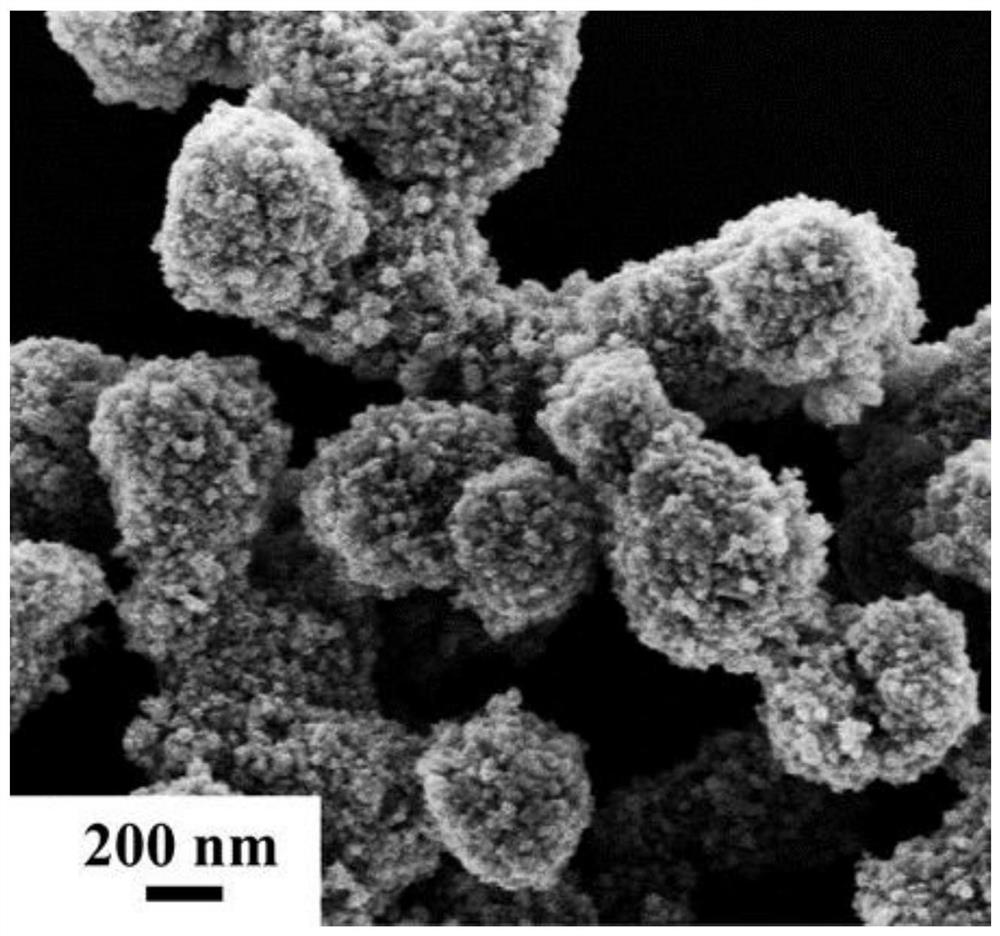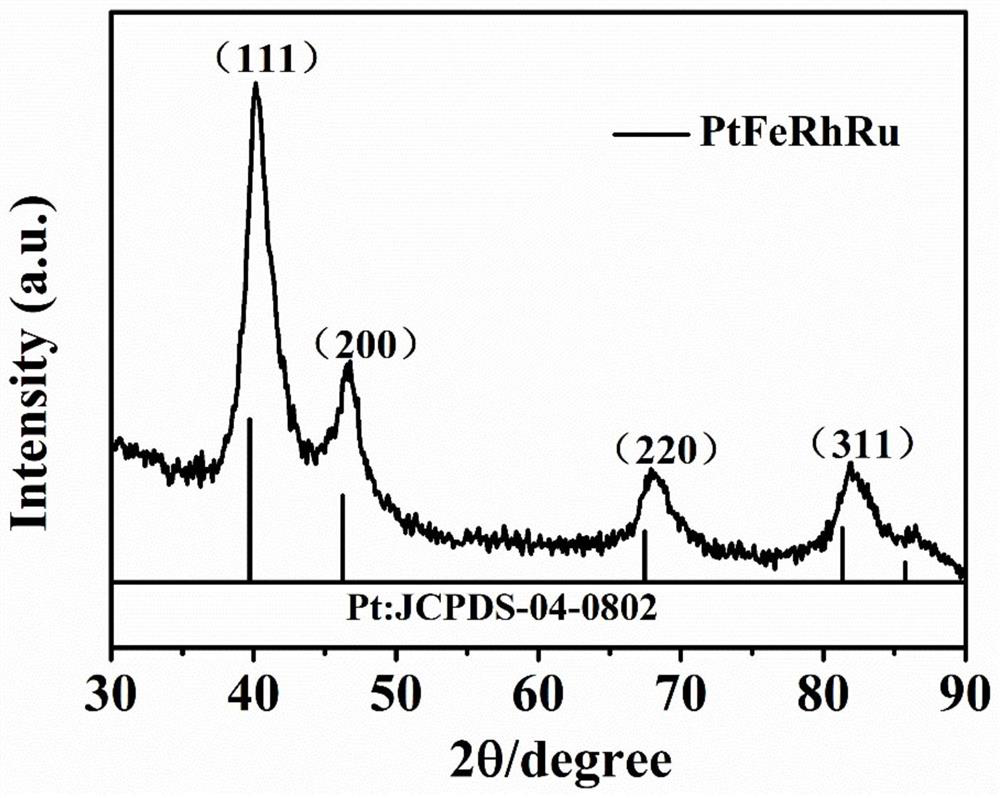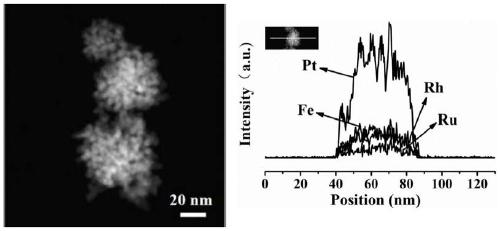Synthesis and application of quaternary platinum-iron-rhodium-ruthenium nano-alloy with hierarchical structure
A hierarchical structure and nano-alloy technology, applied in nanotechnology, nanotechnology, nanotechnology, etc. for materials and surface science, to achieve the effect of novel crystal structure, good stability and excellent catalytic performance
- Summary
- Abstract
- Description
- Claims
- Application Information
AI Technical Summary
Problems solved by technology
Method used
Image
Examples
Embodiment 1
[0019] The synthesis and application of the quaternary platinum-iron-rhodium-ruthenium nano-alloy of hierarchical structure comprises the following steps:
[0020] (1) Add 36.4 mg of cetyltrimethylammonium bromide (CTAB) as a surfactant, and four metal salts of chloroplatinic acid, iron acetylacetonate, rhodium chloride, and ruthenium chloride into the organic solvent octylamine , the amount of metal used is 0.043 mmol, the ratio of platinum salt, iron salt, rhodium salt, and ruthenium salt metal precursor is 25:8:5:5, the volume of octylamine added is 6.2 mL, stirred at room temperature for 10 minutes, and ultrasonicated for 10 minutes , until the metal salt is completely dissolved;
[0021] (2) Add ascorbic acid to the mixed solution obtained in step (1) in an amount of 18 mg, and stir at room temperature for 10 minutes;
[0022] (3) Transfer the mixed solution obtained in step (2) to an autoclave for reaction for 8 hours, with the temperature controlled at 190°C;
[0023]...
Embodiment 2
[0025] (1) Add 36.4 mg of cetyltrimethylammonium bromide (CTAB) as a surfactant, and four metal salts of chloroplatinic acid, iron acetylacetonate, rhodium chloride, and ruthenium chloride into the organic solvent octylamine , the amount of metal used is 0.043 mmol, the ratio of platinum salt, iron salt, rhodium salt, and ruthenium salt metal precursor is 25:8:7:3, the volume of octylamine added is 6.2 mL, stirred at room temperature for 10 minutes, and ultrasonicated for 10 minutes , until the metal salt is completely dissolved;
[0026] (2) Add ascorbic acid to the mixed solution obtained in step (1) in an amount of 18 mg, and stir at room temperature for 10 minutes;
[0027] (3) Transfer the mixed solution obtained in step (2) to an autoclave for reaction for 8 hours, with the temperature controlled at 190°C;
[0028] (4) The product obtained in step (3) is cooled, washed, and centrifuged to obtain a quaternary platinum-iron-rhodium-ruthenium nano-alloy, and the sample is ...
Embodiment 3
[0030] (1) Add 36.4 mg of cetyltrimethylammonium bromide (CTAB) as a surfactant, and four metal salts of chloroplatinic acid, iron acetylacetonate, rhodium chloride, and ruthenium chloride into the organic solvent octylamine , the amount of metal used is 0.043 mmol, the ratio of platinum salt, iron salt, rhodium salt, and ruthenium salt metal precursor is 25:8:3:7, the volume of octylamine added is 6.2 mL, stirred at room temperature for 10 minutes, and ultrasonicated for 10 minutes , until the metal salt is completely dissolved;
[0031] (2) Add ascorbic acid to the mixed solution obtained in step (1) in an amount of 18 mg, and stir at room temperature for 10 minutes;
[0032] (3) Transfer the mixed solution obtained in step (2) to an autoclave for reaction for 8 hours, with the temperature controlled at 190°C;
[0033] (4) The product obtained in step (3) is cooled, washed, and centrifuged to obtain a quaternary platinum-iron-rhodium-ruthenium nano-alloy, and the sample is ...
PUM
 Login to View More
Login to View More Abstract
Description
Claims
Application Information
 Login to View More
Login to View More - R&D
- Intellectual Property
- Life Sciences
- Materials
- Tech Scout
- Unparalleled Data Quality
- Higher Quality Content
- 60% Fewer Hallucinations
Browse by: Latest US Patents, China's latest patents, Technical Efficacy Thesaurus, Application Domain, Technology Topic, Popular Technical Reports.
© 2025 PatSnap. All rights reserved.Legal|Privacy policy|Modern Slavery Act Transparency Statement|Sitemap|About US| Contact US: help@patsnap.com



